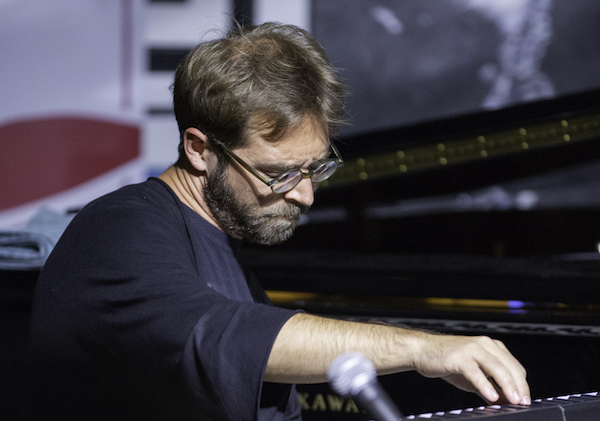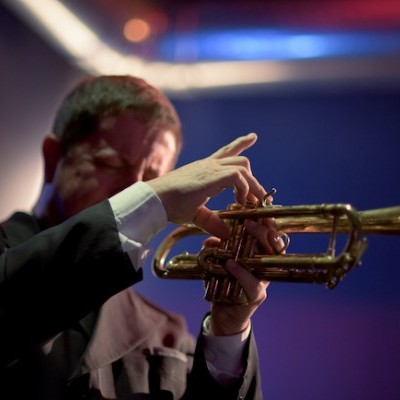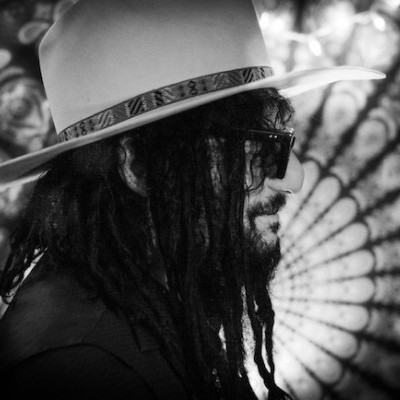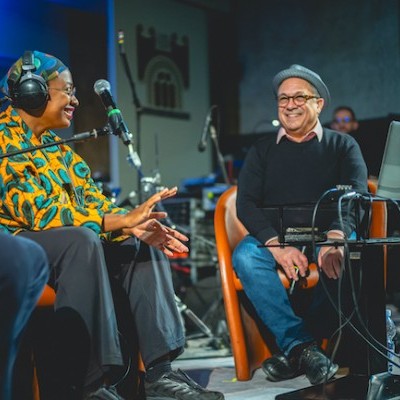Jul 9, 2024 11:35 AM
Trumpeter, Educator Jim Rotondi Dies at 61
Jim Rotondi, a renowned hard-bop trumpeter, composer and educator, died suddenly on July 7 at a hospital in France. He…

Keyboardist Aaron Parks performs with his Little Big ensemble Oct. 9 at Mr. Musichead Gallery in Los Angeles as a part of the Angel City Jazz Festival.
(Photo: Bob Barry)Rocco Somazzi has exceptionally good taste.
At a trendy eatery in the Fairfax district of Los Angeles, the Swiss-born former restaurateur ordered chicken liver toast, marrow bone with chimichurri, and a hamachi tostada with a fish sauce vinaigrette.
“I love marrow,” he said, eagerly scooping up the slippery, seasoned substance directly off what appeared to be a femur. Somazzi gravitates toward things that are unusual and uncommon, and as the founder of L.A.’s Angel City Jazz Festival, it has been his mission to share his eclectic and unorthodox taste in creative improvised music with others.
His passion for presenting this particular strain of jazz compelled him to run a string of innovative jazz rooms in L.A. before organizing the first Angel City festival in 2008. For 2009 and 2010, the event was held at the John Anson Ford Amphitheatre, a 1,200-seat venue well-suited to major acts, but maybe less so for experimental jazz.
“I thought the Ford would give us the visibility for lesser-known artists and more adventurous music that was missing in L.A,” Somazzi recalled. Unfortunately, the audiences didn’t turn out. “It’s a big conflict for us,” he continued, “because we love the venue ... . [T]here’s so many reasons to work there, they almost balance out the extremely hard job of trying to keep the music adventurous, creative and interesting, and [also] get people there. And I haven’t found a solution.”
In 2011, the calculus led Somazzi to begin programming at the Ford, as well as a number of smaller L.A. venues that shared a mission of curating modern jazz. What once was a weekend event with all-day shows has morphed into a two-week affair that ran Oct. 2-13 and featured 19 different groups across seven different venues, including clubs, galleries and theaters. But not the Ford.
Mr. Musichead Gallery, a spacious art house in the heart of Hollywood, hosted a double bill on Oct. 9 highlighting New York-based freestyle vocalist Kokayi, backed by L.A. band Ego Mondo. The ensemble, led by bassist Tim Lefebvre, improvised a series of inventive grooves, shapeshifting into different fantastic beasts of beat music, with cascading ambient sounds overwhelming the sonic landscape. But the articulation came from Kokayi’s otherworldly ability to improvise spoken word, adjusting his freestyles to ever-changing grooves, including a show-stopping stream of 16th-note words over a breakbeat that left the crowd breathless.
The next set, by Aaron Parks’ Little Big, featured somber but tuneful melodies played eloquently in pianist Parks’ right hand, mirrored at almost all times by guitar. The melodies continued unabated into his solos, perpetuated by nimble imagination and seamless, lyrical lines. Parks long has been one of the most accomplished pianists of his generation, and he reminded the gallery of that with every sweeping melodic gesture and sublime chordal invention.
The World Stage in the South L.A. district of Crenshaw once was the home of the Pan-Afrikan Peoples Arkestra, founded by pianist Horace Tapscott. Vocalist Dwight Trible was part of Tapscott’s troupe, and now keeps his mentor’s flame burning as executive director of the venue. Trible’s booming baritone and full-body gesticulations, backed by his multigenerational band, Mothership, was featured in his home venue during the festival, and preceded by avant-garde altoist Darius Jones and pianist Joshua White. Jones, at the Oct. 10 show, sported an arsenal of extended techniques that were almost like electronic manipulations of his horn’s sound, while White rushed into chaotic flights, interrupted by an intermittent barrage of heavy artillery in the lower register of the piano.
The closing night of the festival was at the Lodge Room, a venue in the burgeoning East-L.A. district of Highland Park, which has a reputation for showcasing challenging music that represents the infusion an emerging generation. Alto saxophonist David Binney grew up in Southern California and has of late spent enough time here to find a new platoon of young players who call L.A. home. The energy from Binney’s fiery playing was ably deflected and resonated by his squad. The music overall was brash, intricate and difficult at times, yet the standing-room only capacity crowd of 300-plus took it all in and responded with vigorous ovations.
The final set of the festival went to drummer Makaya McCraven, who reset the evening’s tone with a slow progression that could have been taken from a ’70s soul tune, paired with an undercurrent of double-time rhythm. McCraven’s music manages to introduce complex rhythms in a groovy, accessible way, resulting in a kind of earthiness, which covers up both the headiness and the heaviness of it.
In a way, both Binney’s band and McCraven’s seem to channel the late great bandleader, Art Blakey; Binney with his personal outreach to the next generation of great players, and McCraven with his brand of music that’s meant to connect with the commonality of humanity. Among those in the audience that night were the regular festival attendees, loyal to Somazzi and his vision, mixed with a critical mass of twenty- or thirty-somethings who are part of the new jazz scene, either as players or fans. The two sets put an exclamation point on a wildly successful festival, filled with innovative music and appreciative audiences. Perhaps Somazzi already has found the solution he’s been seeking. DB
Correction: An earlier version of this story included an incorrect date for the first installment of the Angel City festival. The event first ran in 2008. DownBeat regrets the error.

Jim Rotondi was acclaimed for his wide, round trumpet tone, remarkable virtuosity and assured swing.
Jul 9, 2024 11:35 AM
Jim Rotondi, a renowned hard-bop trumpeter, composer and educator, died suddenly on July 7 at a hospital in France. He…

Charles Lloyd, seen here at the 2024 New Orleans Jazz & Heritage Festival, makes DownBeat Poll history!
Jul 11, 2024 12:23 PM
The incomparable Charles Lloyd swept the 72nd Annual DownBeat Critics Poll, becoming the first artist ever to earn…

“Being president of Blue Note has been one of the coolest things that ever happened to me,” Was said. “It’s a gas to serve as one of the caretakers of that legacy.”
Jun 4, 2024 12:21 PM
Sitting with Don Was is a comfortable and unhurried exercise. He may seem slightly reserved at first, but ideas and…

“She reminds me of my childhood and makes we want to cry,” Cécile McLorin Salvant, pictured here with writer Ashley Kahn, said of Dianne Reeves.
Jun 11, 2024 12:31 PM
Italy’s Umbria Jazz Winter is one of those rare annual festivals that not only coincides with a major holiday —…

Maria Schneider said of Decades, her new compilation release: “I just wanted to create something, put it in a beautiful box and say, ‘Look at what we did.‘”
Jun 18, 2024 12:00 PM
Maria Schneider opened the sleek black box and placed it on a coffee table in her Manhattan apartment. Inside lay the…